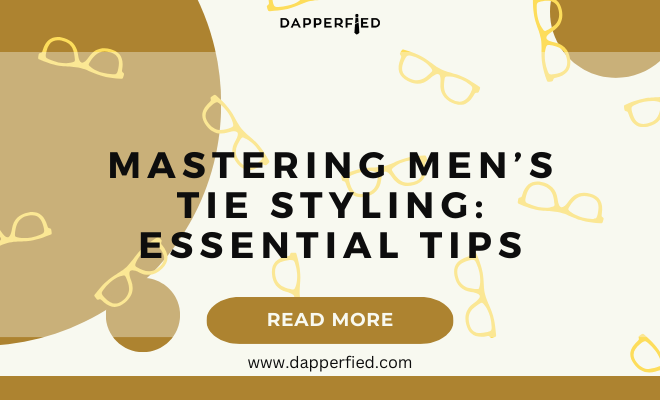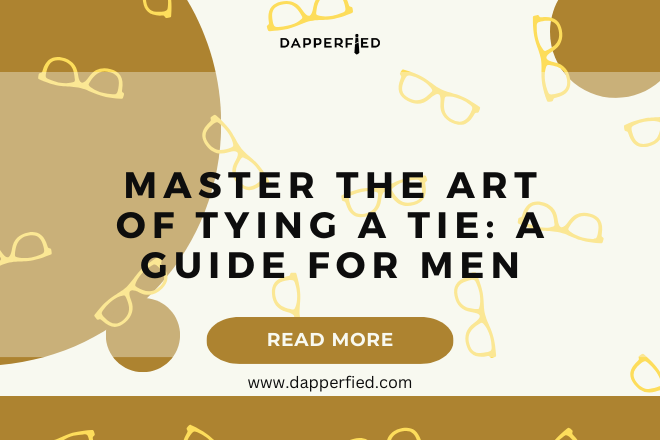
Men's Style
Mastering Men’s Tie Styling: Essential Tips
When it comes to men’s fashion, the tie is a quintessential accessory that can elevate any outfit. There are various types of ties available, each with its own unique material and style. Silk ties are perhaps the most common and versatile type of tie. They are known for their luxurious sheen and smooth texture, making them suitable for both formal and casual occasions. On the other hand, knit ties are made from a more textured fabric, giving them a more casual and relaxed look. They are perfect for adding a touch of personality to a tailored suit or dress shirt. Another popular option is the cotton tie, which is lightweight and breathable, making it ideal for warmer weather. It also has a more casual vibe, making it suitable for business casual or smart-casual attire.
In addition to the material, ties also come in various styles, such as the classic necktie, the bow tie, and the skinny tie. The classic necktie is a timeless choice that can be worn with a variety of shirt and suit combinations. Bow ties, on the other hand, are often associated with formal events and black-tie attire, but they can also be styled in a more casual way for a fashion-forward look. Skinny ties have gained popularity in recent years for their modern and sleek appearance. They are best paired with slim-fit suits and shirts for a contemporary aesthetic. Understanding the different types of ties and their unique characteristics can help men make informed choices when selecting the perfect tie for any occasion.
Key Takeaways
- Silk, knit, and other materials offer different styles of ties for men to choose from
- Coordinating ties with shirt and suit colors and patterns is essential for a polished look
- Classic knots like the Windsor, Half Windsor, and Four-in-Hand each have their own appropriate uses
- The right tie length and width can significantly impact your overall appearance
- Incorporating tie bars, tie clips, and pocket squares can elevate your tie game
Matching Ties with Shirts and Suits
Coordinating ties with shirts and suits is an art that can take an outfit from ordinary to exceptional. When it comes to matching ties with shirts, it’s important to consider both color and pattern. A solid color tie is a safe choice that can be paired with almost any shirt, while patterned ties can add visual interest to an outfit. When matching ties with suits, it’s essential to consider the color and texture of the suit fabric. For example, a navy suit pairs well with a wide range of tie colors, from classic red to modern pastels. A charcoal grey suit, on the other hand, looks sophisticated when paired with a tie in shades of blue or silver.
In addition to color coordination, it’s important to pay attention to patterns. A general rule of thumb is to pair a patterned tie with a solid shirt, or vice versa, to avoid clashing. However, if mixing patterns is desired, it’s essential to ensure that the patterns complement each other in scale and style. For example, a small gingham check shirt can be paired with a larger paisley or striped tie for a visually appealing combination. Understanding how to match ties with shirts and suits can help men create cohesive and polished looks for any occasion.
The Perfect Knot
Tying a tie is an essential skill for any man who wants to look put together and polished. There are several classic knots that every man should know how to tie, each with its own unique characteristics and level of formality. The Windsor knot is a wide and triangular knot that is best suited for spread collar shirts and formal events. It exudes confidence and sophistication, making it a popular choice for business meetings or weddings. The Half Windsor knot is a smaller version of the Windsor knot, making it suitable for most collar types and dress codes. It strikes the perfect balance between elegance and versatility, making it a go-to knot for many men.
For a more casual and relaxed look, the Four-in-Hand knot is an excellent choice. It is a slightly asymmetrical knot that pairs well with narrow collar shirts and is perfect for everyday wear. It’s important to consider the collar type and occasion when choosing which knot to use, as each knot has its own unique aesthetic and level of formality. By mastering the art of tying classic knots, men can ensure that their ties are always perfectly styled for any event or dress code.
Tie Length and Width
| Tie Type | Length (inches) | Width (inches) |
|---|---|---|
| Skinny Tie | 58 | 2 |
| Standard Tie | 58-60 | 3.25-3.75 |
| Bow Tie | 14-18 | 2.5-3 |
The length and width of a tie can significantly impact a man’s overall appearance. A tie that is too long or too short can throw off the proportions of an outfit, while a tie that is too wide or too narrow can look outdated or out of place. The standard length for a tie is around 57-58 inches, which should allow for a proper drape when tied in a knot. Taller men or those who prefer a more modern look may opt for longer ties, while shorter men may need to seek out shorter lengths to avoid excessive fabric hanging below the waistline.
In terms of width, the trend has shifted from wider ties in the past to slimmer ties in recent years. A classic width tie measures around 3-3.5 inches at its widest point, while a skinny tie measures around 2-2.5 inches. The width of the tie should complement the width of the suit lapels and the shirt collar for a harmonious look. It’s important to consider personal style preferences as well as body proportions when selecting the right length and width for a tie. By paying attention to these details, men can ensure that their ties enhance their overall appearance rather than detract from it.
Adding Accessories
Accessories can take a tie ensemble to the next level by adding personality and flair. Tie bars and tie clips are functional accessories that not only keep the tie in place but also add a touch of sophistication to an outfit. They come in various designs and materials, from classic silver bars to modern geometric clips, allowing men to express their personal style through their accessories. Pocket squares are another essential accessory that can elevate a tie ensemble. They come in a wide range of colors and patterns, allowing men to add a pop of color or visual interest to their outfit.
When incorporating accessories into a tie ensemble, it’s important to strike the right balance between functionality and aesthetics. A tie bar should be placed between the third and fourth buttons of the shirt for optimal functionality while adding visual interest to the outfit. Pocket squares should complement the tie without being an exact match, creating a cohesive yet dynamic look. By understanding how to incorporate accessories into a tie ensemble, men can add depth and character to their outfits while showcasing their personal style.
Care and Maintenance

Proper care and maintenance are essential for keeping ties in top condition and ensuring they last for years to come. When not in use, ties should be hung on a tie rack or rolled up and stored in a drawer to prevent wrinkles and creases. It’s important to avoid hanging ties on sharp edges or hooks that can cause damage to the fabric. In terms of cleaning, silk ties should be spot cleaned with a damp cloth or taken to a professional dry cleaner when necessary. Knit ties and cotton ties can typically be hand washed with mild detergent and laid flat to dry.
Ironing ties should be done with caution, using a low heat setting and placing a cloth between the iron and the tie to prevent damage to the fabric. It’s important to avoid using steam when ironing silk ties, as it can cause water spots or damage the fabric. By following these care and maintenance tips, men can ensure that their ties remain in pristine condition and continue to enhance their outfits for years to come.
Breaking the Rules
While understanding traditional tie styles and patterns is important, there is also room for experimentation and creativity when it comes to men’s fashion. Breaking the rules can lead to unexpected yet stylish combinations that showcase individuality and confidence. For example, mixing patterns such as stripes and plaids can create an interesting visual contrast when done thoughtfully. Pairing unconventional tie styles such as knitted ties or floral prints with classic suits can add a modern twist to traditional menswear.
When breaking the rules, it’s important to do so with intention and confidence. Experimenting with unconventional tie styles and patterns should be done thoughtfully, considering factors such as color coordination and overall outfit balance. By breaking the rules in a purposeful manner, men can showcase their personal style while still looking stylish and put together.

In conclusion, understanding the different types of ties, how to match them with shirts and suits, tying classic knots, selecting the right length and width, incorporating accessories, caring for ties, and breaking the rules are all essential aspects of mastering the art of wearing ties as part of men’s fashion. By paying attention to these details and honing these skills, men can ensure that their ties always enhance their overall appearance while showcasing their personal style and confidence.
If you’re looking to elevate your style beyond just ties, check out this article on men’s Italian shoes. Italian shoes are known for their quality and craftsmanship, and they can add a sophisticated touch to any outfit. Whether you’re looking for dress shoes or casual sneakers, Italian footwear is a great investment for any man’s wardrobe.
FAQs
What are some classic tie styles for men?
Some classic tie styles for men include the traditional silk necktie, the skinny tie, the bow tie, and the knit tie.
How should a tie be matched with a shirt and suit?
A tie should complement the color and pattern of the shirt and suit. It is important to consider the overall color scheme and ensure that the tie does not clash with the shirt or suit.
What are some popular tie knots for men?
Some popular tie knots for men include the four-in-hand knot, the half-Windsor knot, and the Windsor knot. Each knot creates a different look and can be chosen based on personal preference and the style of the tie.
What are some tips for wearing a tie with a casual outfit?
When wearing a tie with a casual outfit, consider opting for a knit tie or a patterned tie. Pair the tie with a casual shirt and a more relaxed suit or blazer to achieve a stylish yet laid-back look.
How should a tie be cared for and stored?
To care for a tie, it is important to untie it properly after wearing it and hang it on a tie rack or hanger to maintain its shape. Ties should be stored in a cool, dry place and should be spot cleaned or dry cleaned as needed.














